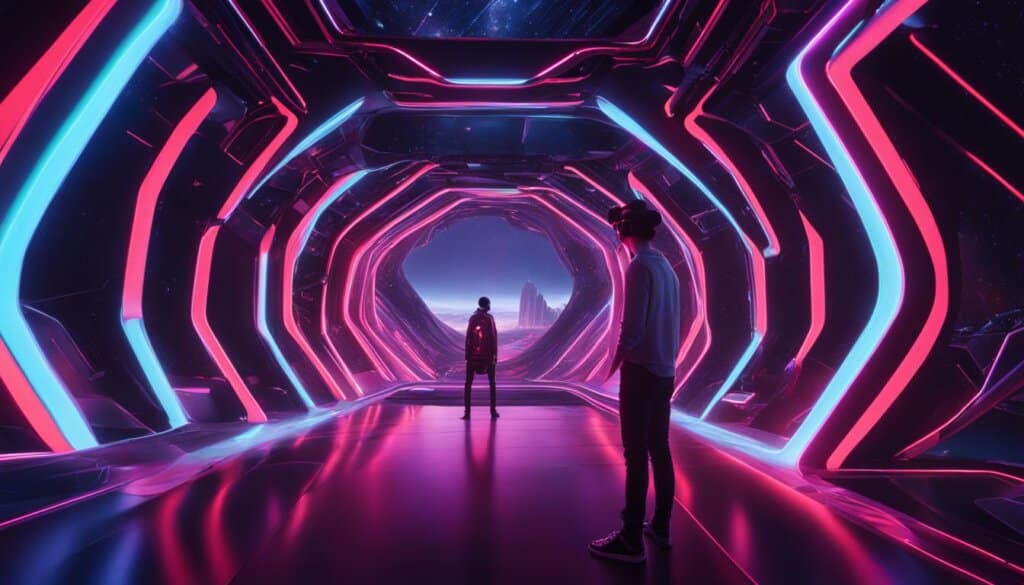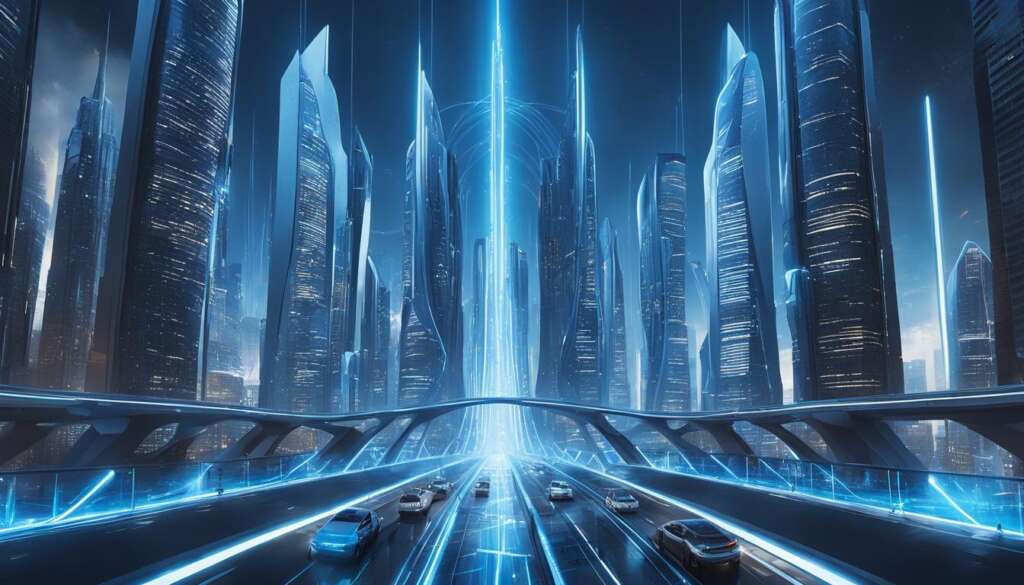Table of Contents
Welcome to the fascinating world of the Metaverse, a virtual universe where digital interaction and immersive experiences come to life. In this guide, we will delve into the depths of this extraordinary realm, exploring its vast possibilities and uncovering the true potential of this virtual frontier.
Imagine stepping into a realm where reality is redefined, where you can connect with others from all corners of the world, trade digital assets, and embark on adventures in virtual worlds. The Metaverse offers an unparalleled level of interaction, blurring the lines between the physical and digital realms, creating a unique and captivating experience for its inhabitants.
Within the Metaverse, you can explore a multitude of virtual environments, indulge in immersive experiences, and engage with dynamic communities. It is a digital ecosystem where the limits of what is possible are constantly being pushed, and where the power of technology paves the way for new human interactions.
The Metaverse is not just a concept of science fiction; it is a tangible reality that continues to evolve and shape the future of how we connect and engage with digital content. Whether you are a fan of virtual reality, gaming, or simply curious about the potential of this digital universe, the Metaverse offers a world of endless opportunities and immersive adventures.
Join us as we embark on this journey through the Metaverse, where virtual reality, augmented reality, and digital communities converge, creating a realm unlike any other. It’s time to unlock the doors to the Metaverse and discover the wonders that await within.
What is the Metaverse?
In the digital realm, an exciting concept known as the Metaverse has emerged. First introduced in Neal Stephenson’s science-fiction novel, Snow Crash, in 1992, the Metaverse has evolved into a vast digital universe where users can engage in immersive and interactive virtual experiences. It is a interconnected web of people, spaces, and experiences that blurs the lines between the physical and digital realms, offering endless possibilities for exploration and interaction.
The Metaverse consists of virtual environments, dynamic communities, and digital spaces that allow users to enter and interact with each other. Users can immerse themselves in various virtual experiences, such as gaming, virtual social interactions, and access to digital assets. It offers a unique platform for individuals to connect, collaborate, and create within a fully realized digital universe.
“The Metaverse is a interconnected web of people, spaces, and experiences that blurs the lines between physical and digital realms.”
In the Metaverse, users have the opportunity to transcend the limitations of physical reality and enter a world where their imagination becomes their only constraint. Through virtual experiences, individuals can explore new horizons, connect with like-minded communities, and engage in activities that were once restricted to the physical world.
Furthermore, the Metaverse allows users to interact with each other in virtual social spaces, forging connections and friendships across geographical boundaries. It is a realm where individuals can express themselves authentically, navigate through virtual worlds, and collaborate on projects and initiatives.
Metaverse at a Glance
Key elements of the Metaverse include:
- Virtual environments: Immersive digital worlds where users can explore and engage in various experiences.
- Dynamic communities: Online spaces where individuals with shared interests come together to socialize, collaborate, and express their creativity.
- Digital assets: Virtual goods, currencies, and resources that hold value within the Metaverse.
- Gaming experiences: Interactive and immersive gaming activities that offer players a chance to delve into unique virtual realms.
Overall, the Metaverse represents an exciting new frontier in digital interaction and virtual experiences. It transcends the boundaries of physical reality, enabling individuals to connect, explore, and create within a digital universe.
Virtual Reality and the Metaverse
Virtual reality (VR) plays a vital role in the Metaverse, offering users an immersive experience like no other. With VR platforms such as Oculus, Valve, and HTC Vive, individuals can dive into virtual worlds, interact with other users, and engage in a wide range of immersive experiences.
By simulating real-world environments, these VR platforms allow users to feel a sense of presence within the Metaverse. Whether it’s exploring fantastical realms, attending virtual events, or collaborating with others in virtual workspaces, VR enhances digital interactions, making them more lifelike and engaging.
One of the key advantages of VR in the Metaverse is the ability to create a truly immersive experience. With the use of specialized headsets, users can step into a virtual world that surrounds them, complete with three-dimensional visuals and spatial audio. This level of immersion fosters a deeper connection to the digital environment and enhances the overall experience of the Metaverse.

Exploring Virtual Worlds
Virtual reality enables users to explore a diverse array of virtual worlds within the Metaverse. These virtual realms offer a vast expanse of possibilities, ranging from realistic simulations to imaginative fantasy environments. Whether it’s exploring ancient civilizations, navigating futuristic cities, or embarking on grand adventures, virtual reality brings these virtual worlds to life.
Users can interact with these virtual environments using hand controllers, allowing them to manipulate objects, solve puzzles, and engage in various activities. This level of interactivity and immersion creates a rich and fulfilling experience for users, enabling them to fully immerse themselves in the virtual worlds of the Metaverse.
Enhancing Digital Interactions
Virtual reality not only offers immersive experiences within virtual worlds but also enhances digital interactions within the Metaverse. With the ability to see and interact with avatars representing other users, VR brings a sense of presence and social connection to the digital realm.
“Virtual reality allows us to have meaningful interactions in the Metaverse, bridging the gap between physical and digital realms. It’s like being in the same room with someone, even if they are miles away.” – Sarah Johnson, VR enthusiast
Through VR, users can engage in virtual social interactions, attend virtual events, and collaborate with others in real-time. This level of immersion and interaction fosters a sense of community and enables users to form meaningful connections within the Metaverse.
Endless Possibilities
The integration of virtual reality into the Metaverse opens up endless possibilities for entertainment, education, and more. From immersive gaming experiences and virtual art galleries to virtual classrooms and training simulations, VR expands the horizons of what can be accomplished within the digital realm.
Through virtual reality, the Metaverse becomes a space where imagination knows no bounds, and individuals can explore, create, and connect in ways previously unimaginable.
Table: Comparison of Popular VR Platforms
| VR Platform | Key Features | Supported Devices |
|---|---|---|
| Oculus | High-quality visuals, intuitive controls | Oculus Quest, Rift S, Oculus Go |
| Valve | Precision tracking, extensive game library | Valve Index |
| HTC Vive | Room-scale tracking, immersive experience | HTC Vive, HTC Vive Pro |
Augmented Reality and the Metaverse
Augmented reality (AR) enhances the Metaverse by overlaying digital information onto the physical world in real-time. AR allows users to see digital information and virtual objects integrated into their immediate environment. This technology has wide-ranging applications in the Metaverse, from digital asset interactions to real-time translations. AR is poised to further revolutionise virtual interactions and experiences within the Metaverse.
With augmented reality, users can access real-time information and seamlessly integrate virtual elements into their physical surroundings. Whether it’s displaying navigation directions, providing contextual information about landmarks, or enhancing gaming experiences with virtual objects, AR brings a new dimension to the Metaverse. It enables users to effortlessly interact with digital content while being fully immersed in the physical world.
The integration of augmented reality and the Metaverse opens up endless possibilities for both personal and professional use. In terms of digital asset interactions, AR allows users to view, manipulate, and experience virtual objects in real-time, enhancing the overall virtual experience. This technology also holds significant promise for industries such as architecture, interior design, and manufacturing, where users can visualize and make real-time changes to virtual prototypes.
Moreover, AR in the Metaverse facilitates real-time translations and language learning. Users can access AR translation tools that overlay translated text onto physical signage, menus, or documents, enabling seamless communication across language barriers. This integration of real-time information with virtual elements empowers users with unprecedented knowledge and connectivity within the Metaverse.
As augmented reality technology continues to evolve, its impact on the Metaverse will grow exponentially. The integration of AR and the Metaverse will create a dynamic and immersive digital environment that blurs the boundaries between the digital and physical worlds. It will enable users to access real-time information, seamlessly integrate virtual elements into their surroundings, and enhance their overall digital experience in the Metaverse.
Take a look at the table below for a comparison of augmented reality and virtual reality:
| Augmented Reality (AR) | Virtual Reality (VR) |
|---|---|
| AR overlays digital information onto the real world. | VR creates a fully immersive digital environment. |
| Offers real-time information and integration with physical surroundings. | Provides a simulated and isolated virtual experience. |
| Enhances existing reality with virtual elements. | Creates a new reality separate from the physical world. |
| Applications include gaming, digital asset interactions, and real-time translations. | Primarily used for immersive gaming experiences and simulations. |
Virtual Worlds and Communities in the Metaverse
The Metaverse offers a multitude of virtual worlds that immerse users in captivating and interactive experiences. These virtual worlds provide an avenue for individuals to engage with others and explore a vast array of virtual objects, creating a profound sense of presence and authenticity.
One of the key aspects of virtual worlds in the Metaverse is the opportunity for social interactions and the formation of online communities. Users can connect with like-minded individuals, collaborate on projects, and build meaningful relationships, all within the digital realm. These digital societies foster a deep sense of belonging and allow individuals to express their identities in a unique and unrestricted manner.
Add Quote: “The virtual worlds within the Metaverse enable people from all walks of life to come together and create remarkable experiences that transcend boundaries.” – Jane Miller, Virtual Reality Enthusiast
In these virtual worlds, users can also participate in vibrant and dynamic virtual economies. Just as real-world economies function, virtual economies within the Metaverse revolve around the exchange of digital goods and services. Users have the ability to buy, sell, and trade virtual assets, generating real-world value and forming the foundation of decentralized economies.
Add List: Virtual Economies in the Metaverse:
- Virtual currencies
- Digital real estate
- Virtual goods and assets
- In-game items
| Virtual World | Description |
|---|---|
| Second Life | A vast virtual world where users create and customize their avatars, explore diverse landscapes, and engage in social activities, commerce, and creative pursuits. |
| Minecraft | A block-based virtual world where users can build and explore their own virtual environments, collaborate on projects, and embark on exciting adventures. |
| Decentraland | An open virtual world powered by blockchain technology, where users can own virtual land, create and monetize content, and participate in a thriving digital economy. |
| Roblox | An immersive virtual world that allows users to play and create games, socialize with friends, and build their virtual empires using simple and powerful game-building tools. |
These virtual worlds and their accompanying communities provide a glimpse into the immense potential of the Metaverse. With the ability to explore, connect, and transact within digital spaces, users can experience a new dimension of existence that merges with the physical world. The combination of virtual worlds, digital societies, and virtual economies contributes to the ongoing evolution of the Metaverse, shaping the future of human interaction and exploring the limitless possibilities of technological advancements.
Gaming in the Metaverse
Gaming plays a crucial role in the Metaverse, providing players with immersive experiences that allow them to delve into digital worlds and simulations. Whether it’s exploring fantastical realms, competing in intense battles, or solving intricate puzzles, gaming in the Metaverse offers a diverse range of interactive and captivating experiences.
One of the key factors that elevates gaming in the Metaverse is virtual reality (VR) technology. VR gaming takes players on a whole new level of immersion by offering interactive experiences through customized avatars and realistic movements. With the help of VR headsets and motion controllers, players can step into virtual environments and inhabit the roles of their in-game characters, truly blurring the line between reality and the digital realm.
“Virtual reality gaming allows players to experience a heightened sense of presence, where they feel like they are physically present in the virtual world,” says Dr. Emily Brown, a gaming researcher at the Virtual Reality Institute. “This level of immersion enhances the overall gaming experience, making it more engaging and captivating.”
The immersive nature of gaming in the Metaverse extends beyond visual and auditory stimuli. It also encompasses haptic feedback, which provides players with physical sensations that correspond to in-game actions and events. For example, if a player’s in-game character gets hit, they may feel a subtle vibration or subtle pressure on their VR controllers, simulating the impact. This level of sensory immersion further enhances the overall gaming experience, making it more realistic and captivating.
In addition to entertainment, gaming in the Metaverse has the potential for various practical applications. Game developers and designers are exploring the use of games as a tool for learning and training. Through simulation-based gameplay, players can acquire new skills, develop problem-solving abilities, and gain real-world knowledge. Industries such as healthcare, aviation, and engineering are already harnessing the power of immersive gaming experiences to enhance training programs and improve performance.
The Future of Gaming in the Metaverse
As technology continues to advance, the possibilities for gaming in the Metaverse are limitless. Game developers and designers are constantly pushing the boundaries of creativity and innovation, shaping the future of interactive entertainment. With advancements in artificial intelligence, augmented reality, and virtual reality, gaming experiences in the Metaverse are set to become even more immersive, realistic, and socially connected.
Imagine a future where players can seamlessly collaborate with others across the globe, exploring vast open worlds and engaging in cooperative gameplay. Virtual reality arcades and arenas could become commonplace, offering shared immersive experiences where players physically interact and compete. The potential for cross-platform integration and the merging of physical and virtual spaces will unlock new dimensions of gaming immersion, making the Metaverse a truly transformative and interconnected gaming landscape.
The image below illustrates the immersive gaming experiences in the Metaverse:
| Advantages of Gaming in the Metaverse | Challenges of Gaming in the Metaverse |
|---|---|
|
|
The Future of the Internet: Metaverse Expansion
The Metaverse is revolutionizing the way we experience the internet, presenting a future where digital presence and online interactions are enhanced. As this digital universe continues to evolve, boundaries between the physical and digital worlds become increasingly blurred, creating a unique ecosystem that offers unprecedented opportunities for digital disruption.
One of the key areas where the Metaverse is set to make a significant impact is in entertainment. With immersive virtual reality experiences, users can dive into breathtaking virtual worlds, interact with other users, and engage in a wide range of captivating activities. Gaming is another realm that will be transformed by the Metaverse, as it offers not only entertainment value but also the potential for learning and training through simulation.
In addition to entertainment, the Metaverse holds immense potential for social networking. Imagine a digital realm where individuals can connect, collaborate, and engage with others on a whole new level. Virtual communities within the Metaverse foster a sense of belonging and provide platforms for individuals to express themselves authentically in virtual spaces. These digital interactions have the power to transcend physical boundaries and bring people together from all corners of the globe.
As advancements in virtual reality, augmented reality, and artificial intelligence continue to push the boundaries of what is possible, the Metaverse will undoubtedly shape the future of the internet. It opens up a multitude of possibilities for how we connect, collaborate, and experience digital content. The metaverse signifies a new era, where the boundaries of reality and digital experiences blend seamlessly, and the potential for innovation is boundless.
FAQ
What is the Metaverse?
The Metaverse is a vast digital universe that encompasses virtual reality, digital communities, and immersive experiences. It offers users the opportunity to interact with each other through virtual worlds and social networks, trade digital assets, play immersive games, and explore the potential of technology and future human interactions.
What is virtual reality and its role in the Metaverse?
Virtual reality is a key component of the Metaverse, providing users with a fully immersive and interactive 3D experience. Virtual reality platforms such as Oculus, Valve, and HTC Vive allow users to explore virtual worlds, interact with other users, and engage in a range of immersive experiences. These platforms simulate real-world environments and enable users to have a sense of presence within the Metaverse, enhancing digital interactions and offering endless possibilities for entertainment, education, and more.
How does augmented reality enhance the Metaverse?
Augmented reality (AR) enhances the Metaverse by overlaying digital information onto the physical world in real-time. AR allows users to see digital information and virtual objects integrated into their immediate environment. This technology has wide-ranging applications in the Metaverse, from digital asset interactions to real-time translations. AR is poised to further revolutionize virtual interactions and experiences within the Metaverse.
What are virtual worlds and communities in the Metaverse?
The Metaverse is host to numerous virtual worlds that provide users with immersive experiences. These virtual worlds allow users to interact with others and various virtual objects, creating a sense of presence and authenticity. Social interactions and online communities are vital in these virtual worlds, fostering a sense of belonging and identity. Additionally, virtual economies exist within the Metaverse, where users can engage in commerce and build decentralized economies around digital goods and services.
How does gaming fit into the Metaverse?
Gaming is a significant part of the Metaverse, offering immersive experiences for players to explore digital worlds and simulations. Virtual reality gaming takes gaming in the Metaverse to the next level by providing users with interactive experiences using customized avatars and realistic movements. The possibilities for game developers in the Metaverse are vast, with potential applications beyond entertainment, including learning and training via simulation.
What is the future of the internet with the Metaverse?
The Metaverse is poised to shape the future of the internet, as it enhances digital presence and transforms online interactions. As the Metaverse continues to evolve, it will create a unique digital ecosystem that blurs the line between the physical and digital worlds. It presents opportunities for digital disruption in entertainment, gaming, and social networking. With advancements in virtual reality, augmented reality, and artificial intelligence, the Metaverse will revolutionize the way we connect, collaborate, and experience digital content.













